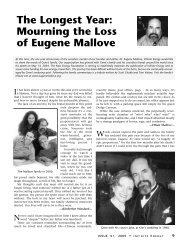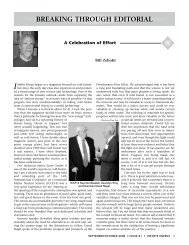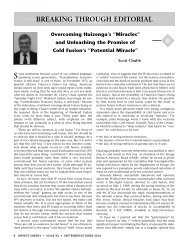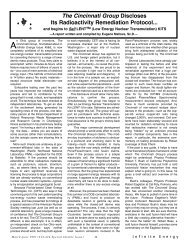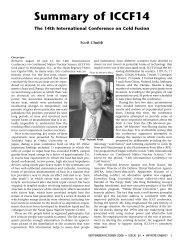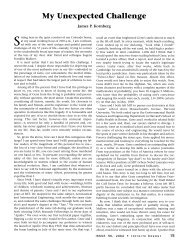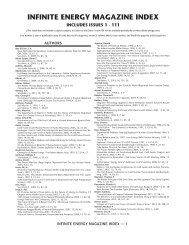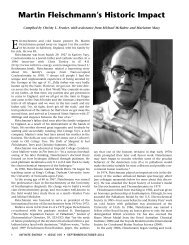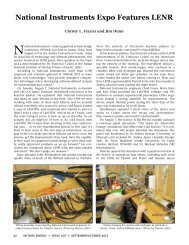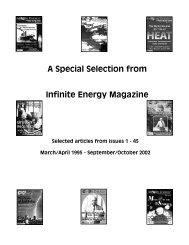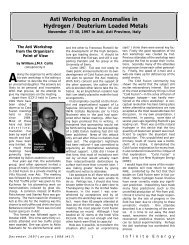MIT and Cold Fusion: A Special Report - Infinite Energy Magazine
MIT and Cold Fusion: A Special Report - Infinite Energy Magazine
MIT and Cold Fusion: A Special Report - Infinite Energy Magazine
You also want an ePaper? Increase the reach of your titles
YUMPU automatically turns print PDFs into web optimized ePapers that Google loves.
TO: Prof. Phil Morrison<br />
FROM: Dr. Stan Luckhardt<br />
<strong>MIT</strong> Plasma <strong>Fusion</strong> Center, NW16-266<br />
DATE: 3/10/92<br />
SUBJECT: ANALYSIS OF CALORIMETRY DATA IN<br />
THE PAPER: D. Albagii et al., Journal of <strong>Fusion</strong> <strong>Energy</strong>, 9, 133, (1990).<br />
In this memo, I will go through the analysis of the calorimeter data<br />
from our 1989 experiment, <strong>and</strong> show how we arrived at the reduced data<br />
presented in our paper. As explained in our paper, the calorimeter used a<br />
feedback controlled heating element to maintain a constant temperature<br />
in the electrolytic cells. Any production of “excess heat” would show up<br />
as a reduction in the heater power level. The heater power level could be<br />
accurately measured by monitoring the current <strong>and</strong> voltage applied to<br />
the resistive heating element. The signal of interest is then the heater<br />
power (P h = I h x V h ). The level of excess heat claimed by Fleischmann &<br />
Pons for our conditions is ~79 mW, this excess was claimed to appear<br />
after an initial “loading period” of some hours or days. Thus, to reproduce<br />
the claimed effect, we would expect the heater power to undergo a<br />
change of the claimed magnitude after some days of “loading.”<br />
In our experiments, <strong>and</strong> those of others using the open cell type<br />
calorimeters, the heater power undergoes a steady drift caused by the<br />
loss of solvent from the cell. This loss is caused mainly by electrolytic<br />
decomposition <strong>and</strong> evaporation. As solvent is lost, the level of solvent<br />
in the cell drops, this causes the thermal conduction path from the solvent<br />
to the top of the cell to increase, thus increasing the thermal “resistance”<br />
of the cell <strong>and</strong> reducing the rate of heat flow out of the cell. To<br />
maintain constant cell temperature, the heater power must also<br />
decrease slowly. This base line drift trend can be seen in the raw heater<br />
power plots attached.<br />
To analyze our heater power data, we first subtract the baseline drift,<br />
then any onset of anomalous heating would appear as an excursion<br />
from zero. In particular, in the attached Figs. 2&3 I show the raw heater<br />
power data P H for the D 2 0 cell <strong>and</strong> the linear regression fit y H to the<br />
raw data. In Fig. 4 the difference<br />
P X = Y H - P H is shown. To remove the high frequency fluctuations, the<br />
data is time averaged, Fig. 5. We believe these rapid fluctuations are<br />
caused by the trapping <strong>and</strong> escape of gas bubbles from under the Teflon<br />
supports for the cell electrodes, (see drawing of the cell in our paper) <strong>and</strong><br />
by condensation in the cell which causes water droplets to occasionally<br />
fall back into the cell. These effects cause fluctuations in the level of liquid<br />
<strong>and</strong> as explained above result in heater power fluctuations.<br />
The time averaged data has one main feature, a slow variation having<br />
a 24 hour period. We believe this is caused by daily room temperature<br />
variations <strong>and</strong>/or some sunlight hitting the cells. Both the D 2 O <strong>and</strong><br />
H 2 O cells exhibit this feature. Aside from this 24 hour period variation,<br />
the data is quite close to zero with some residual fluctuations of order<br />
10-20mW. There does not appear to be any evidence of the claimed<br />
anomalous heating event of magnitude 79mW in Fig. 5. This conclusion<br />
was stated in our paper.<br />
Sampling rate: As noted in the caption of Fig. 6 in our paper, the data<br />
sampling rate for the D 2 O cell power was reduced at t=30hours. This<br />
was done to save disk space on the data acquisition computer. The<br />
regression analysis described above tends to weight the initial data<br />
more heavily because of its higher sampling rate. In the attached pages,<br />
I show a further analysis in which a uniform sampling rate is used<br />
throughout. In the attached Figs. 6-9 the data analysis is carried out<br />
again using the uniform sampling rate data <strong>and</strong> the final time averaged<br />
signal is plotted in Fig. 9. This signal is almost indistinguishable<br />
from the results of the original analysis shown in Fig. 5. So our conclusion<br />
from this analysis is the same as before.<br />
The analysis of the H 2 O cell data is shown in Figs. 10-14. Note the in Fig.<br />
14 there is a residual, 24 hour period variation in the heater power. As discussed<br />
above we believe this is an error signal caused by the daily variation<br />
of the room temperature <strong>and</strong>/or variation in sunlight hitting the cells.<br />
I hope this brief summary is of use to you, please feel free to contact<br />
me at 3-8606 if you need further information.<br />
Exhibit Z-4<br />
Dr. Charles McCutchen’s Letter to<br />
<strong>MIT</strong> President Dr. Charles Vest<br />
March 19, 1992<br />
DEPARTMENT OF HEALTH, EDUCATION,<br />
AND WELFARE<br />
PUBLIC HEALTH SERVICE,<br />
NATIONAL INSTITUTES OF HEALTH<br />
BETHESDA, MARYLAND 20892 Bldg. 8, Room 403<br />
Dr. Charles McCutchen<br />
<strong>MIT</strong> Photo<br />
I had asked NIH physicist Dr. Charles McCutchen to give me his<br />
opinion of the <strong>MIT</strong> PFC experiment <strong>and</strong> my interchanges with<br />
<strong>MIT</strong>. Dr. McCutchen, who with <strong>MIT</strong> Professor Robert Mann had<br />
had his own battles with unethical establishments, obliged <strong>and</strong><br />
wrote to President Vest supporting my position.—EFM<br />
Charles M. Vest, Massachusetts Institute of Technology<br />
Dear Dr. Vest,<br />
Eugene Mallove has sent me material about the <strong>MIT</strong> cold<br />
fusion experiment. Mallove contends that calorimeter data were<br />
manipulated to suppress experimental evidence that excess<br />
heat was generated when heavy water was electrolyzed. I can<br />
see why he is disturbed.<br />
The experiment was not a gem. Of the 1.8 to 2.1 watts that<br />
went into each electrolysis cell, 1.25 to 1.55 watts were supplied<br />
by the heater. Over two thirds of the power entering the cell did<br />
not go into electrolysis. Any signal from excess power would<br />
have been diluted by more than a factor three.<br />
Worse was the variability of the total power input. Over an interval<br />
of 80 hours, the heater power declined progressively by almost<br />
20%. The experimenters ascribe this to the steady fall in level of the<br />
solution ln the cell. This reduced the working area of the heat-loss<br />
path through the insulation surrounding the cell, <strong>and</strong> lowered the<br />
power needed to keep the cell at constant temperature.<br />
Power generation by cold fusion, if lt happened, would likewise<br />
be revealed by a reduction in heater power. The potential<br />
for confusion is obvious.<br />
In his letter of August 8, 1991 to Eugene Mallove, Ronald<br />
Parker wrote, “The implicit assumption was that we were looking<br />
for a fast turnon of the anomalous heat production <strong>and</strong> so it<br />
was legitimate to subtract out a slow baseline drift caused by<br />
depletion of the electrolyte.” This would have been a reasonable<br />
position, had the experimenters stated it in the paper. They<br />
did not do so. The ordinates of their figures are labeled P x , elsewhere<br />
defined as unknown (i.e. excess) power, zero is marked<br />
on the ordinates, <strong>and</strong> nowhere is it stated that the height <strong>and</strong><br />
slope of the curves mean nothing.<br />
Had they wanted to be able to detect constant or slowly varying<br />
excess power the experimenters should have improved<br />
their calorimeters to get rid of the baseline slope. Their<br />
calorimeter depends on the constancy of the thermal conductance<br />
of its insulation, <strong>and</strong> steps should have been taken to<br />
make it constant. They could have put a thermally conductive<br />
sleeve between the cell <strong>and</strong> its insulation so as to keep the area<br />
of the heat path constant. They could have kept the solution at<br />
a constant level in the cell. Better, they could have done both.<br />
They did neither. Instead, they say they subtracted a linear<br />
ramp from the data for apparent excess power in each cell. How<br />
they picked the height <strong>and</strong> slope of the ramp is not stated.<br />
Because I took their graphs of excess power to mean what they<br />
said, I assumed that they thought their procedure would not<br />
have concealed constant or slowly varying excess power, had<br />
such occurred.<br />
52 <strong>Infinite</strong> <strong>Energy</strong> • ISSUE 24, 1999 • <strong>MIT</strong> <strong>Special</strong> <strong>Report</strong>



